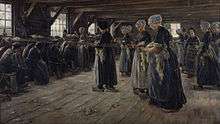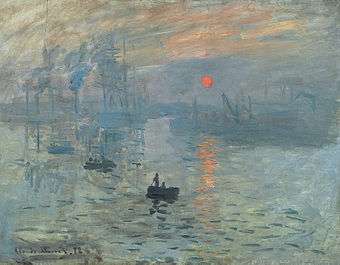Max Liebermann

Max Liebermann (20 July 1847 – 8 February 1935) was a German-Jewish painter and printmaker, and one of the leading proponents of Impressionism in Germany.
Biography

The son of a Jewish fabric manufacturer turned banker [1] from Berlin, Liebermann grew up in an imposing town house alongside the Brandenburg Gate.[2] He first studied law and philosophy at the University of Berlin, but later studied painting and drawing in Weimar in 1869, in Paris in 1872, and in the Netherlands in 1876–77. During the Franco-Prussian War (1870–71), Liebermann served as a medic with the Order of St. John near Metz. After living and working for some time in Munich, he finally returned to Berlin in 1884, where he remained for the rest of his life. He was married in 1884 to Martha Marckwald (1857–1943, see portrait by Anders Zorn).[3]

He used his own inherited wealth to assemble an impressive collection of French Impressionist works. He later chose scenes of the bourgeoisie, as well as aspects of his garden near Lake Wannsee, as motifs for his paintings. In Berlin, he became a famous painter of portraits; his work is especially close in spirit to Édouard Manet. In his work he steered away from religious subject matter, with one cautionary exception being an early painting, The 12-Year-Old Jesus in the Temple With the Scholars (1879). His painting of a Semitic-looking boy Jesus conferring with Jewish scholars sparked debate.[1] At the International Art Show in Munich it stirred up a storm for its supposed blasphemy, with one critic describing Jesus as "the ugliest, most impertinent Jewish boy imaginable."[2] Noted for his portraits (he did more than 200 commissioned ones over the years, including of Albert Einstein and Paul von Hindenburg), Liebermann also painted himself from time to time.[2]


On the occasion of his 50th birthday, Liebermann was given a solo exhibition at the Prussian Academy of Arts in Berlin, and the following year he was elected to the academy.[1] From 1899 to 1911 he led the premier avant-garde formation in Germany, the Berlin Secession. In his various capacities as a leader in the artistic community, Liebermann spoke out often for the separation of art and politics. He did contribute regularly to a newspaper put out by artists during World War I.[1] He pushed for the right of artists to do their own thing, unconcerned with politics or ideology, and his interest in French Realism went against conservatives who viewed it as an offensive incursion.[2]
Beginning in 1920 he was president of the Prussian Academy of Arts. In 1933 he resigned when the academy decided to no longer exhibit works by Jewish artists, before he would have been forced to do so under laws restricting the rights of Jews.[1] While watching the Nazis celebrate their victory by marching through the Brandenburg Gate, Liebermann was reported to have commented: "Ich kann gar nicht soviel fressen, wie ich kotzen möchte." ("I could not possibly eat as much as I would like to throw up.").[1]

In 1909 Liebermann bought property in Wannsee, a wealthy suburb of summer homes on the outskirts of Berlin, and designed a villa with gardens there. From the 1910s until his death, images of the gardens dominated his work.[1] Together with Lovis Corinth and Max Slevogt, Liebermann became an exponent of German Impressionism.
On his 80th birthday, in 1927, Liebermann was celebrated with a large exhibition, declared an honorary citizen of Berlin and hailed in a cover story in Berlin's leading illustrated magazine.[1]
Liebermann died on February 8, 1935, at his home on Berlin's Pariser Platz, near the Brandenburg Gate. According to Käthe Kollwitz, he fell asleep about 7 p.m. and was gone.[4]
Although Liebermann had been famous, his death was not reported in the media, now controlled by the Nazis, and there were no representatives of the Academy of the Arts or the city at his funeral in the Jewish Cemetery on Schönhauser Allee. However, despite official strictures by the Gestapo, more than 100 friends and relatives attended the funeral. Among the mourners were Kollwitz, Hans Purrmann, Otto Nagel, Ferdinand Sauerbruch, Bruno Cassirer, Georg Kolbe, Max J. Friedländer and Adolph Goldschmidt.[5]
Commemoration

In 2005/2006, the Skirball Cultural Center in Los Angeles and the Jewish Museum in New York mounted the first major museum exhibition in the United States of Liebermann's work.[2]
On 30 April 2006 the Max Liebermann Society opened a permanent museum in the Liebermann family's villa in the Wannsee district of Berlin.[6] The artist's wife, Martha Liebermann, was forced to sell the villa in 1940. On 5 March 1943, at the age of 85 and bedridden from a stroke, she was notified to get ready for deportation to Theresienstadt concentration camp.[7] Instead, she committed suicide in the family home, Haus Liebermann, hours before police arrived to take her away. There is a stolperstein for her in front of their former home by the Brandenburg Gate in Berlin.[7]
In 2011, the Israel Museum returned a painting to the Max Liebermann estate, decades after the masterpiece was looted from a Jewish museum in Nazi Germany. Liebermann had loaned his painting to the Jewish Museum in Berlin in the 1930s. The work, along with many others, disappeared from the museum during World War II.[8]
His painting Riders on the Beach was found as part of the 2012 Nazi loot discovery.[9]
Gallery
 The Artist's Studio, 1902
The Artist's Studio, 1902 Two Riders on the Beach, 1901
Two Riders on the Beach, 1901 Riding Donkey at the Seashore, 1900
Riding Donkey at the Seashore, 1900 Restaurant Terrace in Nienstedten, 1902
Restaurant Terrace in Nienstedten, 1902 Boys Bathing, 1898
Boys Bathing, 1898 Portrait of President Paul von Hindenburg 1927
Portrait of President Paul von Hindenburg 1927 Bleaching on the Lawn, 1892
Bleaching on the Lawn, 1892
References
- 1 2 3 4 5 6 7 8 Leah Ollman (September 30, 2005), A dramatic life; the work, not quite so Los Angeles Times.
- 1 2 3 4 5 Grace Glueck (March 20, 2006), A Berlin Painter, Jewish and Proudly Assimilated New York Times.
- ↑ Martha Liebermann (Marckwald) geni.com. Retrieved October 30, 2011
- ↑ Käthe Kollwitz: Die Tagebücher 1908–1943. Hrsg. von Jutta Bohnke-Kollwitz. btb, München 2007. Eintrag vom 9. Februar 1935.
- ↑ Saul Friedländer: Das Dritte Reich und die Juden, Beck’sche Reihe, München 2010, Seite 24
- ↑ http://www.max-liebermann.de
- 1 2 "Ein Stein für Martha Liebermann" Frankfurter Allgemeine Zeitung, official website. (June 9, 2005) Retrieved July 21, 2010 (German)
- ↑ Museum returns looted painting Los Angeles Times, September 9, 2011.
- ↑ "Photo Gallery: Munich Nazi Art Stash Revealed". Spiegel. 17 November 2013. Retrieved 17 November 2013.
External links
| Wikimedia Commons has media related to Max Liebermann. |
- Works by Max Liebermann at Project Gutenberg
- Works by or about Max Liebermann at Internet Archive
- Works by Max Liebermann at LibriVox (public domain audiobooks)

- German masters of the nineteenth century: paintings and drawings from the Federal Republic of Germany, a full text exhibition catalog from The Metropolitan Museum of Art, which contains material on Max Liebermann (no. 50-55)
- Gallery of Liebermann's paintings at zeno.org
- Guide to the Max Liebermann Collection at the Leo Baeck Institute, New York.
-
 Chisholm, Hugh, ed. (1911). "Liebermann, Max". Encyclopædia Britannica (11th ed.). Cambridge University Press.
Chisholm, Hugh, ed. (1911). "Liebermann, Max". Encyclopædia Britannica (11th ed.). Cambridge University Press.
